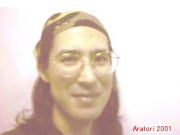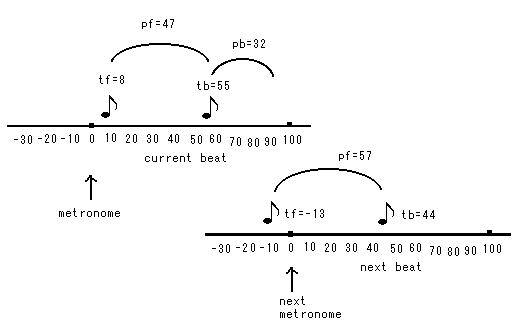

sample movie/picture welcome concept research sound MP3 MENU/other languages Blog "Atonal Swing"


Page bienvenue (Outline comprenant 10 secondes d'echantillon MP3) Welcome page (Outline including 10 seconds of sound sample) |
Questions Le but Questions The Aim |
Quel est bounce? (Quelle est swing?) Pourquoi avons-nous besoin de timing fluctuation ? Quelle est improvisation? Comment ecoutons-nous et jeu, ou percevez unnotated timing? Cet site timing-progression.com cherche ces questions au moyen de mathematiques, philosophie aussi bien que, naturellement, la pratique des decennies. What is bounce? (What is swing?) Why do we need timing fluctuation? What is improvisation? How do we listen and play, or perceive unnotated timing? This site timing-progression.com seeks these questions by means of mathematics, philosophy as well as, of course, decades' practice. |
Unnotated timing |
TP |
Bienvenue a timing-progression.com a presente par Aratori (keyboarder de jazz). Si vous etes un musicien ou un auditeur, qui est interesse par la musique ou le jazz d'improvisational invente au milieu du 20eme siecle, timing progression (TP) peut fournir la nouvelle perspective pour vous. Je (Aratori) souhait soutenir, TP est l'essence de l'invention du jazz et peut non seulement intensifier swinging sentiment mais egalement constituer la musique meme sans chord progression. Welcome to timing-progression.com presented by Aratori (jazz keyboarder). If you are a musician or a listener, who is interested in the improvisational music or jazz invented at the middle of the 20th century, timing progression (TP) may provide new perspective for you. TP, I (Aratori) claim, is the essence of the invention of jazz and can not only intensify swinging feeling but also constitute music even without chord progression. |
 Aratori, jazz keyboarder |
| Quel est TP? What is TP? |
Tandis que chord progression individuates et constitue la musique en se usage de sequence de l'harmonie, TP le fait en se usage de sequence de unnotated timing. While chord progression individuates and constitutes music by making use of sequence of harmony, TP does by making use of sequence of unnotated timing. |
NOTE 1, Aratori's idea |
| Ecoutez TP music MP3 Listen to TP music MP3 |
Download et ecoutez TP music. (Any des donnees des musique de cet emplacement est libre.) Click ci-dessous. Les 8 premieres barres de "timing-progression.com Aratori Vol. 1" (Si vous liberez MP3 du Windows Media Player, vous pouvez download MP3.) Download and listen to TP music. (Any of this site's sound data is download-free.) Click below. The first 8 bars of "timing-progression.com Aratori Vol. 1" MP3 (128kbps) 0:00:13 207KB (If you release MP3 from Windows Media Player, you can download it.) |
TP music Plus de musique More sound Donnees d'enregistrement Recording data Achetez le CD Buy CD |
TP proportion graph |
Voyons la fluctuation de timing du musique ci-dessus pendant que vous ecoutez le dossier MP3. Figure 1 est TP proportion graph. Proportion, qui est un des proprietes du TP, est exemplifie dans le Figure 2 ci-dessous. Le black est pf, le rouge est pb. Let's see timing fluctuation of the sound above as you listen to the downloaded MP3 file. Figure 1 is TP proportion graph. Proportion, which is one of the most important properties of TP, is exemplified in Figure 2 below.  Figure 1 TP proportion graph of first 8 bars of "timing-progression.com Aratori Vol. 1" Black point is pf, red one is pb. |
NOTE 2, perceiving TP TP proportion graph Proportion Agrandissez Figure 1 (grande taille) Enlarge Figure 1 (big size) Agrandissez Figure 1 (la taille moyenne) Enlarge Figure 1 (medium size) |
| Proportion |  Figure 2 Example of timing and proportion Figure 2 Example of timing and proportion |
one metronome beat = 100 (defined) tf: timing of front eighth note tb: timing of back eighth note pf: proportion of front eighth note pb: proportion of back eighth note bl=pf+pb =beat length |
| Vous trouverez comment les timings fluctuate. Il n'y a aucun rapport fixe ou longueur d'eux. Puis, comment est ce planton, structure et bounce de swinging-sentiment? Pouvez-vous faire le solfeggio les proportions of eighth notes par des oreilles? Pouvez-vous imaginer ou chantez les proportions d'elles? Au contraire, pourquoi les prenons-nous comme le 'eighth notes' independamment d'avoir considerable timing fluctuation? You will find how the timings fluctuate. There is no fixed ratio or length of them. Then, how is this orderly, structured and swinging-feeling bounce? Can you do solfeggio the proportions of eighth notes by ears? Can you imagine in your mind or hum the proportions of them? Why do we, on the contrary, take them as 'eighth notes' regardless of having considerable timing fluctuation? |
Solfeggio TP? Imagine TP? Probleme philosophique Solfeggio TP? Imagine TP? Philosophical problem |
|
| Unnotated timing symbol |
Le bounce est rapporte pas par notated symbol mais unnotated timing symbol, qui ne peut pas etre transcrit en partition. Le symbole, historiquement et socialement considere comme ephemere et contingent, n'a pas ete analyse en comparaison de notated symbol, ce qui est transcrit en partitions. D'abord, il n'y a eu aucun dispositif pour l'identifier. The bounce is yielded not by notated symbol but by unnotated timing symbol, which can not be transcribed into score. The symbol, historically and socially regarded as ephemeral and contingent, has not been analyzed compared to notated symbol, which is transcribed into score. First, there has been no device for identifying it. |
Notated symbol Unnotated timing symbol ,NOTE 3, symbol |
Telescope Piano MIDI |
Au 17eme siecle, un nouveau telescope de dispositif a incite Galilee a pouvoir presenter fortement le concept "mais il [ la Terre ] bouge". Le telescope etait le dispositif qui relativized la Terre et les satellites. Au 18eme siecle, un nouveau instrument piano (pianoforte), qui a eu piano/forte et resonnant son avec le tonie stable, a fait la fleur de musique de partition. Il peut dire que le piano etait un dispositif pour identifier les son correspondant aux partition. Au milieu du 20eme siecle, la diffusion des dispositifs de son de recording/representing a incite l'invention du jazz. Ils ont donne des sentiments de jazz et donnent maintenant une quantite enorme assez de musique pour nous ennuyer. Et enfin, en annees 1990, le systeme MIDI, qui peut enregistrer, mesurer et representer timing en precise, a commence a etre disponible. Ne pensez-vous pas naturellement le nouveau dispositif nous aiderez-vous a soutenir le nouveau concept de la musique? Si oui, le nouveau concept doit etre au sujet du son ne correspondant pas aux partition. In the 17th century, a new device telescope made Galileo Galilei be able to strongly present the concept "And yet it [the earth] does move". The telescope was the device which relativized the earth and satellites. In the 18th century, a new instrument piano (pianoforte), which had piano/forte and resonant sound with stable pitch, made score music blossom. It can be said that piano was a device to identify the sound corresponding to scores. At the middle of the 20th century, the spread of sound recording/representing devices prompted the invention of jazz. They conveyed jazz feelings and now convey a huge amount of music enough to bore us. And at last, in 1990's, MIDI system, which can record, measure and represent precise (unnotated) timing, began to be available. Don't you naturally think the new device will help us to bear new concept of music? If so, new concept must be about the sound corresponding not to scores. |
Identification of score sound Identification of TP sound? |
| Le dispositif est necessaire mais, naturellement, non suffisant. En second lieu, il n'y a eu aucune musique experimentale qui prend unnotated timing symbol en tant que constitutif et considere l'autre symbole comme contingent. Maintenant, j' le soutenir est TP music, qui a besoin de pratique des decennies pour jouer et de 100,000-times ecoutant percevoir TP. Bien que nous puissions etre forces de penser les sciences nous developpions tellement rapidement, notre perception et la comprehension pour le domaine tout a fait nouveau change aussi lentement qu'elle a fait en ere de Galilee. The device is necessary but, of course, not sufficient. Second, there has been no experimental music which takes unnotated timing symbol as constitutive and regard other symbol as contingent. Now, I claim that is TP music, which needs decades' practice for playing and 100,000-times listening for perceiving TP. Though we may be forced to think present sciences are developing so rapidly, our perception and understanding for utterly new realm improves as slowly as it did in Galileo's era. |
TP music as experimental one |
|
Unnotated timing perception |
Nous sommes maintenant au depart de la longue route cherchant l'enigme des bounce et unnotated timing. TP vous veut, qui peut etre un auditeur, un musicien, un mathematicien, un philosophe ou un chercheur de la science de cerveau. Joignons les experiences de la perception de timing! We are now at the departure of the long road seeking the riddle of bounce and unnotated timing. TP wants you, who may be a listener, musician, mathematician, philosopher or brain science researcher. Let's join experiments of unnotated timing perception! |
| NOTEZ 1 Aratori's idee NOTE 1 Aratori's idea |
Chaque musicien de jazz doit peuvent savoir que le rythme subtile participe a constituer la musique de jazz. Mais l'idee, au moyen d'experience des decennies (pratique) de methodologie, differencier d'autre notated symbol et, faire et nommer de la fonction (TP) de, et essayer de rechercher l'enigme de 'unnotated timing symbol', est Aratori. Every jazz musician must know that subtle rhythm takes part in induviating jazz music. But the idea, by means of decades' experiment (practice) of methodology, of distinguishing from other notated symbol, prompting and naming the function (TP) of, and trying to research the riddle of 'unnotated timing symbol', is Aratori's. |
| NOTEZ 2 NOTE 2 Perceiving TP |
Si vous avez l'ennui en percevant le TP tout en regardant TP graph, il suggere tel vision et attitude d'analyser conflits avec la perception de unnotated timing. If you have trouble in perceiving TP while looking TP graph, it suggests that such sense of sight or *analyzing attitude conflicts with the perception of unnotated timing. |
MORE to Method |
| NOTEZ 3 Symbol NOTE 3 Symbol |
J'utilise symbol comme Nelson Goodman utilise: "as a very general and colorless term. It covers letters, words, texts, pictures, diagrams, maps, models, and more, but carries no implication of the oblique or the occult. The most literal portrait and the most prosaic passage are as much symbols, and as 'highly symbolic', as the most fanciful and figurative" (Languages of Art, p.xi). Nous ne pouvons percevoir rien sans fonction de symbol. I use symbol like Nelson Goodman's use: "as a very general and colorless term. It covers letters, words, texts, pictures, diagrams, maps, models, and more, but carries no implication of the oblique or the occult. The most literal portrait and the most prosaic passage are as much symbols, and as 'highly symbolic', as the most fanciful and figurative" (Languages of Art, p.xi). We can not perceive anything without the function of symbol. |
Copyright 2002 Aratori